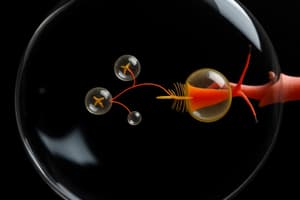Podcast
Questions and Answers
What is external fertilization?
What is external fertilization?
External fertilization is a reproductive process where eggs and sperm are released into the water for fertilization to occur.
What are the advantages of external fertilization?
What are the advantages of external fertilization?
External fertilization increases the probability of successful fertilization and allows for rapid reproduction.
How does external fertilization increase the chances of successful fertilization?
How does external fertilization increase the chances of successful fertilization?
External fertilization increases the chances of successful fertilization by liberating numerous eggs and sperm into the water.
How do sea urchins and starfish reproduce?
How do sea urchins and starfish reproduce?
What are some disadvantages of external fertilization?
What are some disadvantages of external fertilization?
What insights can understanding external fertilization provide?
What insights can understanding external fertilization provide?
What is external fertilization?
What is external fertilization?
How does external fertilization differ from internal fertilization?
How does external fertilization differ from internal fertilization?
Which group of animals is known for engaging in external fertilization?
Which group of animals is known for engaging in external fertilization?
What advantage does external fertilization provide to fish in large bodies of water?
What advantage does external fertilization provide to fish in large bodies of water?
Which animals exhibit both internal and external fertilization processes?
Which animals exhibit both internal and external fertilization processes?
Why is external fertilization advantageous for some animals?
Why is external fertilization advantageous for some animals?
Flashcards are hidden until you start studying
Study Notes
Sexual Reproduction in Animals: Exploring External Fertilization
Sexual reproduction is a fundamental process for the perpetuation of life forms, including animals. This dynamic and complex process involves the fusion of gametes (sex cells) from two distinct individuals, resulting in the formation of a new, genetically unique offspring. In some animals, the fertilization process takes place externally, outside of the female's body. This phenomenon is known as external fertilization, and it is the primary focus of this article.
The Process of External Fertilization
In external fertilization, which is common in aquatic environments, sperm and eggs are released into the surrounding water. The eggs and sperm then fuse, leading to fertilization. This method differs from internal fertilization, where sperm are deposited into the female's reproductive tract, and fertilization occurs within her body.
Fish and External Fertilization
Fish are the most prominent group of animals that engage in external fertilization. Many species of fish release their eggs and sperm into the water simultaneously, resulting in a mass fertilization event. This process is particularly advantageous to fish living in large, open bodies of water, as it increases the likelihood that the eggs will be fertilized by sperm from a genetically compatible male.
Amphibians: A Mixed Approach
Amphibians, on the other hand, exhibit both internal and external fertilization processes. Some species of amphibians engage in amplexus, a reproductive behavior where the male grasps the female with his forelimbs, and fertilization occurs internally. However, many amphibians, like frogs and toads, practice external fertilization. The female releases her eggs into water, and the male fertilizes them by depositing sperm on the egg mass.
Sea Urchins and Starfish: An Echinoderm Perspective
Echinoderms, including sea urchins and starfish, are invertebrates that engage in external fertilization. The male and female release sperm and eggs simultaneously into the water, where fertilization occurs. The resulting fertilized egg, or zygote, develops into a free-swimming larva that eventually settles onto the sea floor and metamorphoses into the adult form.
Advantages of External Fertilization
External fertilization has several advantages, particularly for aquatic animals. For instance, it increases the probability of successful fertilization, as the liberation of numerous eggs and sperm into the water increases the chances of a successful encounter between them. Additionally, external fertilization allows for rapid reproduction, as fertilization does not require a specific location within the female's body.
Disadvantages of External Fertilization
Despite these advantages, external fertilization also presents potential disadvantages. For example, the eggs are more vulnerable to predation and environmental factors, such as temperature fluctuations and water quality. Furthermore, the offspring of external fertilization are often smaller and less developed than those resulting from internal fertilization, as they must rely on their own resources at a younger age.
Conclusion
External fertilization is a significant aspect of sexual reproduction in animals, particularly those living in aquatic environments. This process offers several advantages, including increased chances of successful fertilization and rapid reproduction. However, it also presents challenges, such as increased vulnerability of the eggs and less developed offspring. Understanding the complexities of external fertilization can provide valuable insights into the evolutionary adaptations of various animal groups and contribute to our broader knowledge of biological processes in the natural world.
Studying That Suits You
Use AI to generate personalized quizzes and flashcards to suit your learning preferences.




